Community Curation
Published in ATÖLYE Insights · 18 min read · March 16, 2018
An all-encompassing guide to our community curation
Author: Atılım Şahin, Creative Hub Director, Editor: Emre Erbirer
The term 'Curation' has become a ubiquitous notion lately. We hear this buzzword from corporate customer acquisition narratives to content creation platforms across sectors such as music, travel, dining and more.
At ATÖLYE, we live by this word as we think about our projects, events and most importantly, people. In this article, we would like to touch upon why it is important, what our intentions are and how we try to build our community through a diligent curation process.
We did our homework in terms of scanning through previous essays (most of which are quoted), and believe that our model can contribute to the global discourse with its applied guidelines pertaining to space, purpose and diversity.
Curation has become almost indispensable in a world of excess
Around 10 years ago, the term 'curation' had a more limited definition. Back then, what we understood from curation was merely related to museums or art exhibitions. The etymological journey of the word also implies that it has been used to impress selecting, organizing and looking after the art pieces in various contexts since 19th century.
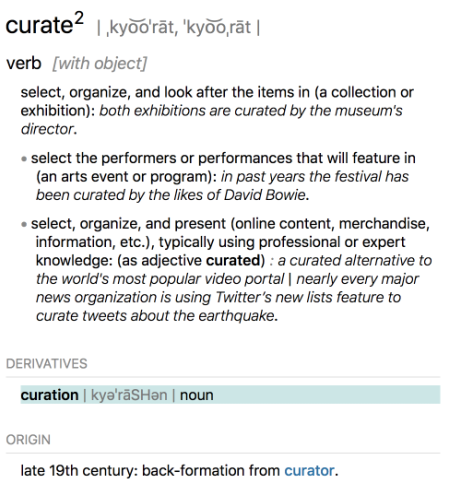
In his book, Michael Bhaskar remarks how this term we borrowed from the art world has turned out to be a critical, yet sometimes controversial strategy for our age. (Curation: The power of selection in a world of excess, 2016) He points out that today's most successful companies like Apple, Netflix, Amazon use "curation" to empower their growth by offering their clients more customised and appropriate choices.
As Bhaskar also emphasizes, it seems like excess is the key term to explain this transformation. We are now inundated with more information and more goods than we know what to do with. Moving from scarcity to abundance on accessing the information makes selecting, finding and cutting down to show what really matters more crucial. In this abundancy, people are used to having a wide variety of choices. Thus, expectations become higher, people expect more customised stuff to be put in front of them. And the fact that a filtering process has taken place, makes people more likely to engage in the final content. The curation becomes almost a required expectation.
Scarcity breeds engagement.
An intriguing article by Cedric Giorgi (Founder of French Startupers Community) compares 2 different Facebook groups (owned by him) in terms of communities' engagements levels. (Linkedin, 2017)

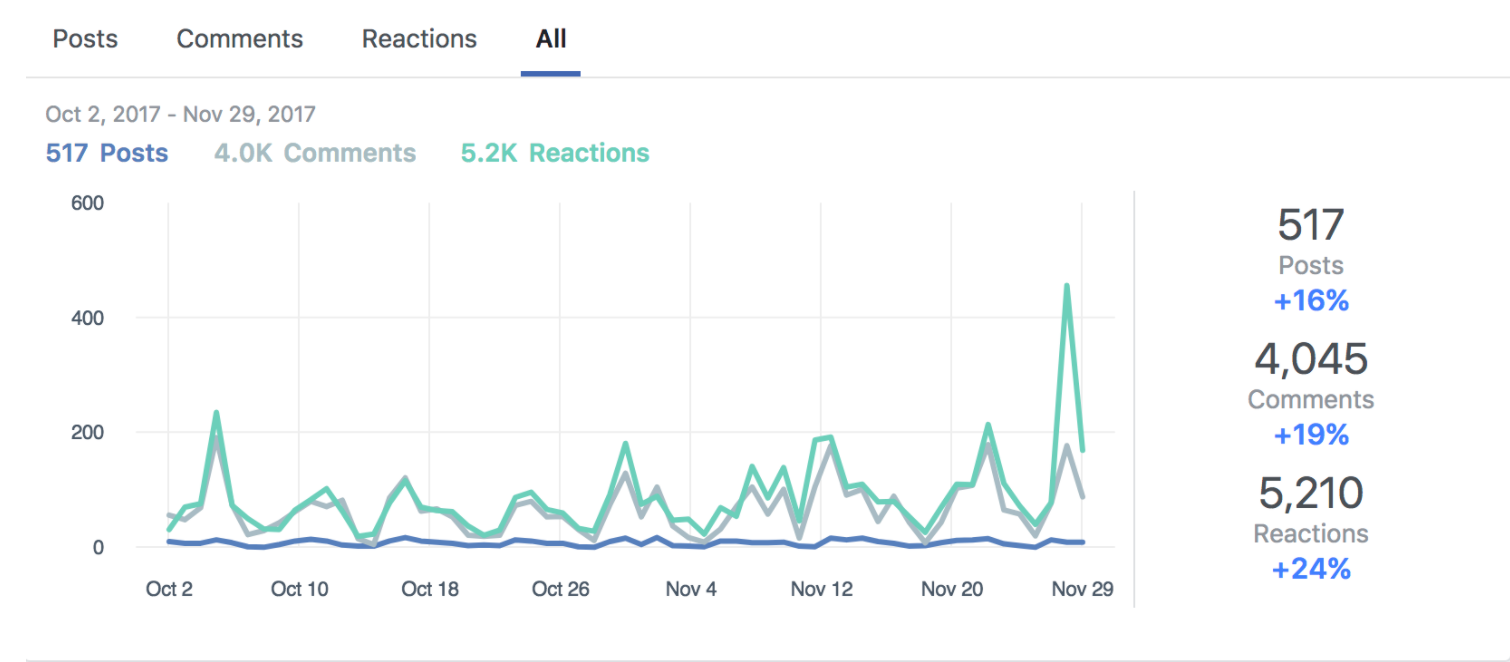
First group is completely open to join and open to post any content whereas the second group was selective on members and restrictive on what is posted. There are nearly 3 times more members with a bit more wall posts in the first group, however, the engagement levels (based on comments + reactions) demonstrates a significant difference in the favour of the curated one (second group).
Communities and curation: ''With whom I am together with? ''
Just like curation, the traditional definition of community seems to be outdated. It is interesting to think about the evolvement of the word community in line with curation and understand both of their relation to the term excess.
In the past, communities were more likely associated with a group of people living in the same physical location: neighbourhood, school, town. This is what the dictionary definition suggests in the first place as well. However, community, now, implies a meaning that is not merely something that we born or fit into; it is something we choose for ourselves and express our identities through (The Atlantic, 2017). The community has no physical or geographical boundaries.
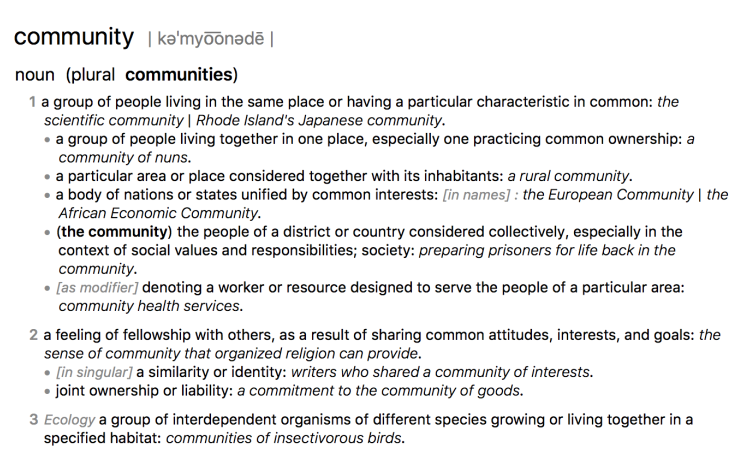
Thanks to the revolutionized social media methods of interaction, we -millenials that are born into abundance - have incredibly easy access to the wider clusters of people. While abundance occurs in the numbers of people we could access, the question of ''With whom I am together with?'' started to be easily raised up. We tend to choose our communities depends on our shared values, interests or needs. This is where communities start to be built around shared purposes and needs instead of physical links. Community, itself, derives curation automatically and that happens around shared purposes.
We have shared purposes. So, aren't we done with being a community yet?
Not likely.
Everyone has millions of different goals and interests that they could share with others. However, it is fair to say that having a shared purpose would not be enough for communities to exist unless the members of the community care about each other. Interesting podcast from Victoria Stoyanova, a community architect, reveals the core qualities of curating strong communities around a common purpose. One of the key points that she mentions is to constitute ownership and trust among members. Even simple details like celebrating birthdays or remembering one's dog's name become crucial to establish these relationships. If we are not listening and caring about each other, there are no ways we could show off our vulnerabilities and this would end up with becoming a simple people group instead of community.
Community Builder Fabian Pfortmüller nicely examines the shift in our understanding of communities in his article and describes the difference between communities and other similar people groups (Medium, 2017). Unlike project teams, companies or political movements optimizing for external purposes (collective goals); communities optimise for internal purposes (the relationship and the shared identity). What separates communities from the rest of the groups is that they come together around an internal purpose.

There must be a person assigned to catalyze these relationships and establish trust carefully and systematically in each community. This person is certainly not a receptionist sitting at the entrance of the space that the community gathers. Some people like community managers / builders / architects / curators are the ones who lead this process for communities to survive and reach to the external and internal purposes collectively. That is mainly actualized through creating a safe space for community members to take initiative.
''We are against boundaries, our community is open to everyone.''
While talking to people especially in the context of creative hubs, I personally hear the upper quote a lot, as if it is a strategy to build a community. However, it is seriously hard to understand how being open to everyone might reinforce a community, at least for me. Is it seriously possible to make a community open to everyone?
Executive consultant Charles Vogl shares a really nice insight on this manner, in his article, ''Why do communities need boundaries?'':
''If everyone is inside your community, then your community cannot be distinguished from no community. Acknowledging the boundary between your community and the outside world helps you create something as opposed to nothing.''
If people are running businesses around communities (like in creative hubs or in coworking spaces), they, of course, need to think about the financial sustainability of the organization. In that case, taking anyone to the community purely from a financial point of view would become an easy way out sometimes. That is not incorrect; the sustainability of the organization comes in the first place naturally. What is incorrect, from my point of view; is to acknowledge the term community as an open boundary matter to get more members in.
Some might think that applying curation criteria/boundaries would be an elitist or a snobby approach in building communities. But, not all boundaries are always bad; especially if we structure them around a certain purpose. Boundaries can be used to create a safe space where vulnerability could be shared. We do not acknowledge borders as strict walls to protect the community; but instead, we see them as permeable membranes in order for communities to transmit and receive from the outside world effectively. People from outside of the community should intervene in some of the community processes to reinforce the community as well. Only in this way, we could facilitate a grounding for organic relationships to breed inside the community.
COMMUNITY CURATION IN PRACTICE
After clarifying what we, as ATÖLYE, understand from community curation, it makes sense to boil down some of the key aspects both in curation and community; and explain how we merge these as a toolkit in ATÖLYE's community curation. These toolkits are related to space, purpose and diversity.
SpaceRight neighbours vs. right house: A guide for community curation
In Turkish, we have a proverb which could be directly translated as "Choose the right neighbour, not the right house." We are highly inspired by this notion while curating our community at ATÖLYE. Our approach, ''Build Community, Space Will Come'' directly refers to this adoption that communities should be built not depended on physical attachments (Medium, 2017). This mindset shapes the way we curate our community. If people would like to join ATÖLYE just for working in a comfortable space without any other steering motivations, we could easily say that they are not the right fit for the community.
This approach also gives clues about our growth strategy regarding the community. In contrary to many space-driven ventures based on real-estate mindset, we prefer to put our energy into the curation of the community in order to engage right people to create a unique synergy. Because we believe this synergy would turn into something that could create value in the long run. This vision has been broadly discussed in one of our Medium posts titled 'Deceleration: In Praise of Slowness and Trust' (Medium, 2017) If we had planned to expand through the number of members we would have continued with opening the second space and fill it with new people.
Space, in our case, affects our curation by means of limiting the capacity. Since last year, we are around 150 people, our full capacity, which makes us tighten the curation processes with new criteria in every iteration. While designing our space, we configured our membership models (part time, full time and corporate) so as to allow 150 people to be fit in the community. This decision was inspired by Dunbar's number. According to the anthropologist Dunbar, this is the number of people with whom we can maintain a meaningful relationship, whether in a hunter-gatherer society or on online groups.
It is interesting that our experience at ATÖLYE so far shows that people clusters engage more in Dunbar's suggested subsequences (5–15–50–150). In parallel with that, the daily traffic of our space is around 50 people; and in community activities, most efficient knowledge sharing environments are being provoked when there are 15 people at most.
Purpose
Clearly communicating internal and external purposes from day one and reminding it throughout the process is essential in the curation of a community.
We attach a great deal of importance to carefully maintaining both an interdisciplinary and an interpersonal balance when putting together the ATÖLYE community. The main purpose of curating ATÖLYE community is to create a learning environment in which community members fulfil their needs professionally and socially, build capacity to reveal their own potentials; and collaborate on projects that could create long term value.
This might sound like a general purpose which could be easily internalized by everyone. However, the key approach for us is to look for members who can contribute to this purpose, not fit into it.
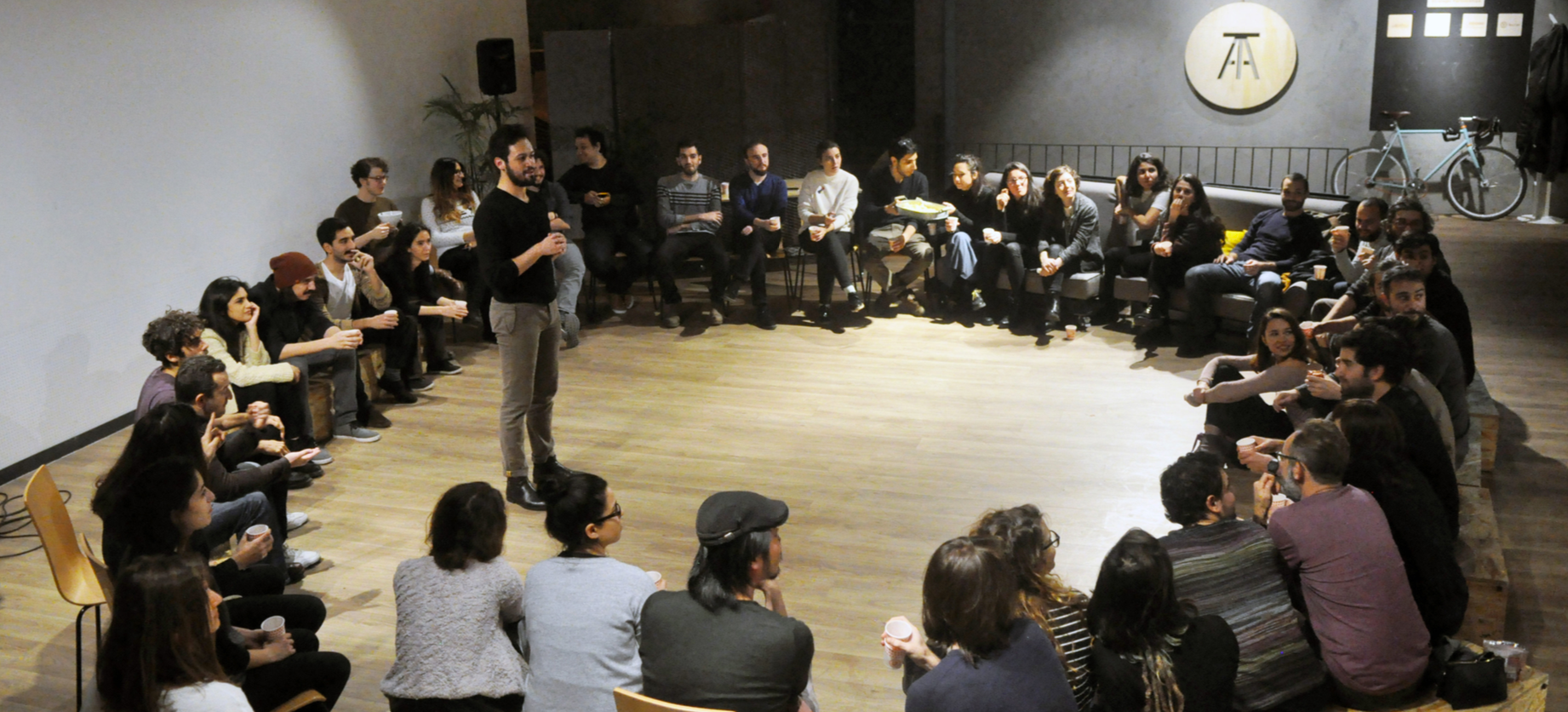
Being a contributor to the defined purpose is more important than being a proper fit for the community.
Diego Rodriguez, the former partner of IDEO, addresses hiring criteria in relation to team culture in his article (Linkedin, 2015). He prioritizes cultural contribution over cultural fit in choosing the right candidates. Similarly, we try to understand how a candidate member would contribute to this purpose and what they could bring to the table for the sake of the community. We examine this through our membership application process.
The first touch point for people willing to join ATÖLYE community is the membership application form on our website. This form gives applicants the first hint about the curation we apply and its purpose.
After reviewing the form, we invite people for a coffee at 1:1 meeting. These meetings take approximately one hour per candidate. They are not typical 'space tour's to show off space and it's amenities. Instead, these are sincere conversations to communicate the fact that people matter at ATÖLYE. It is very important for us to talk face-to-face with people who are interested in being a part of the community so that we can elaborate on what their expectations are, how they work best, what their interests are, how they could possibly support people in the community and how they could benefit from the community in return.
These meetings also give us a chance to know more about candidates' future plans in terms of new projects and venture prospects. This allows us to see possible collaboration opportunities they could make with other members and ATÖLYE's strategic design studio team. Through this discussion, candidates could also acknowledge the value of community as a way of supporting each other professionally.
On the other hand, through these meetings, we communicate the fact that what keeps our community together is the relationships among members. We grow through the strength of the bonds between members, not with the actual numbers of them. Trust is the key constituent in order to reach an internal purpose. Without trust, there are no relationships, no friendships, no collaborations. This approach automatically eliminates people with egocentric tendencies on the way if they think they wouldn't need anything from anyone.
The reason that we try to handle application processes diligently, is to communicate our purpose from the first day, explain our expectations and sign a -kind of- social contract together. Even if people apply in teams, we would like to meet not only with the leader of the team but also each team member in order to be on the same page altogether.
Diversity Scarcity breeds engagement & quality.
Diversity is one of the most crucial curation criteria at ATÖLYE. Aligned with our purpose defined above, we think that innovative projects and unexpected breakthroughs can only emerge out of the right mix of people. Points of inspiration boost through the diversity of knowledge and viewpoints. The institutions like Stanford d.school and NYU ITP are perfect examples of how putting people from various disciplines together almost always leads to breakthroughs that each group could never reach alone.
In quantitative manners, there are several criteria we apply in the curation of our community. We keep track of this data on daily basis. It is challenging to regulate this flow as we sometimes accept big teams, that change the balances instantly. Similarly, our churn is affected by members moving abroad or teams out-growing space. Within this dynamic system, diversity remains a difficult yet worthwhile metric.
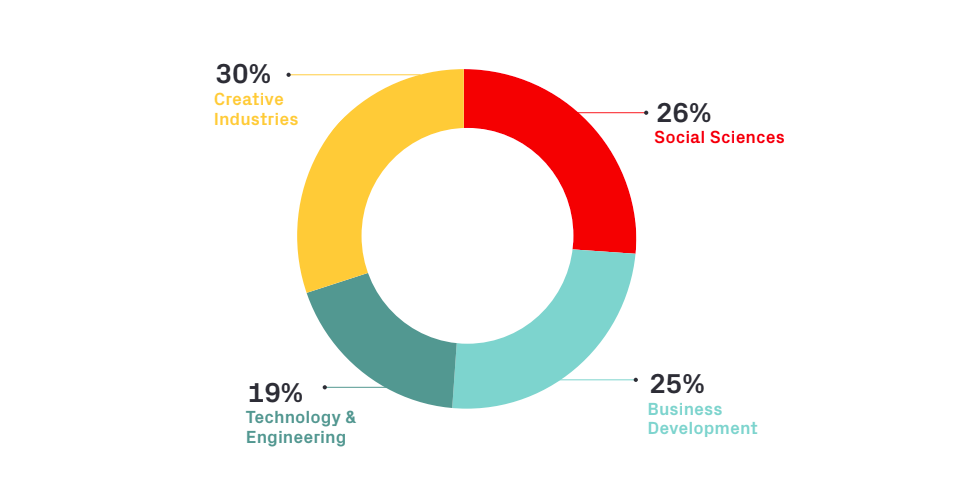
Disciplinary balance: We divide disciplines into four main scopes in ATÖLYE, and we aim for a disciplined balance between those four areas:
- Creative Industries: Aimed 30%; current 30% of the community (Includes Designers: Product, Service, System, Graphic, UX/UI; Architects, Photographers, Videographers, Artists, Illustrators, Animators)
- Technology & Engineering Aimed 25%; current 19% of the community (Includes Engineers: Computer, Software,Mechanical, Civil, Electrical-Electronics; Developers)
- Strategy & Business Development Aimed 25%; current 25% of the community (Includes Entrepreneurs, Strategists, Business Developers, Advisors, Coaches)
- Social Sciences & Community Building Aimed 20%; current 26% of the community (Includes Communication Experts, Sociologists, Researchers, Lawyers, Psychologists, Writers, Editors)
Under these four scopes, we do not prefer to have more than 6 people from the same profession. That means there wouldn't be more than 6 graphic designers, for instance, in Creative Industries scope. This network is mapped using an interactive interface called Graph Commons, which also happens to be an ATÖLYE alumni venture. The way we approach discipline diversity is inspired by how we embrace the transdisciplinarity. This vision could be reviewed in our Medium Post, Transdisciplinarity as an Intent in detail.
Gender Balance: Since the beginning, we have been aiming for 1:1 gender ratio within our community. It is an equal number for males and females at the moment.
International people ratio: 10% of our community is international people. We work rigorously towards increasing that figure to 15–20%. We believe cultural diversity is one of the key aspects to create an effective learning and inspiring environment. In order to increase the numbers of foreigner people dropping by to ATÖLYE, we have started to collaborate with Yabangee, an English resource & community platform for expats living in Istanbul. Together with Yabangee, we organize events (Expat Spotlight) and distribute articles, targeting expats.
Diligent Evaluation Process Curation requires a team focussed on the process thoroughly.
In our approach at ATÖLYE, we use 'curation' not only for selecting people in our community but also as a way of utilizing interaction potential with the selected ones. We believe the curation process requires a diligent team focus starting from the first touch with the members via the application form until the first day the member spends within the community.
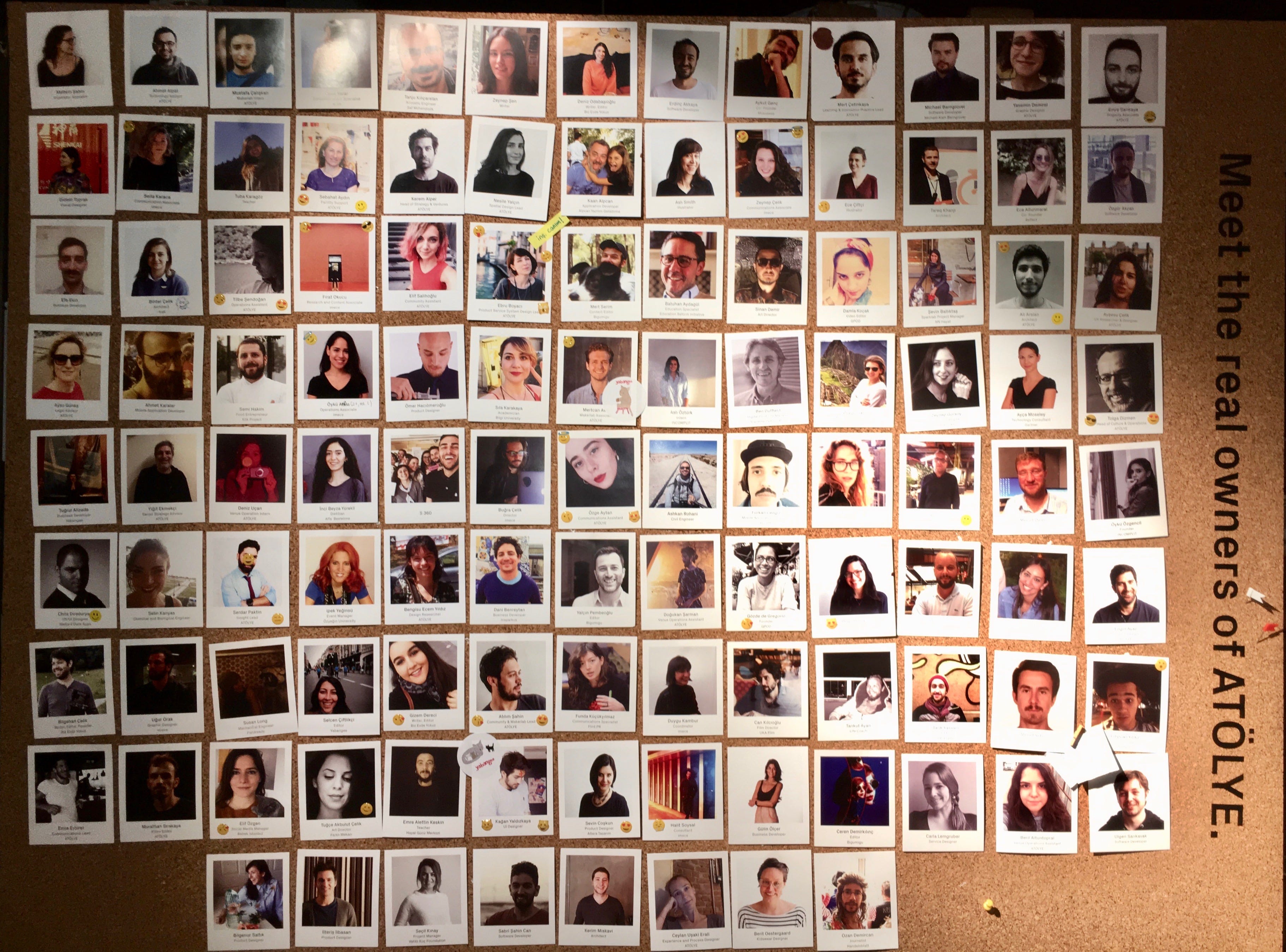
On a weekly basis, we make internal team meetings for final evaluation of applications for that week. The evaluation starts with discussing the above mentioned curation criteria for the candidate: space, purpose and diversity. We then continue with assessment and ranking of the candidate with reference to the three topics listed below. In order to reveal their importance for us, these three topics are listed in hierarchical order as follows:
- Collaboration potentialWe seek out people that contribute to the agenda of ATÖLYE's strategic design studio arm as well as the current member professional profile in terms of collaborations.
- Community engagement potentialWe seek out people that could engage with the community in different ways. That could be achieved through participating in the events, organizing workshops/101 classes/feedback sessions; being active in communication channels and being physically present in space in the desired frequency. Everyone is interacting with the community in a different way and we keep track of it on a regular basis.
- Professional RecognitionWe seek for minimum 2, ideally 4+ year of professional experience on the related field. However, this does not mean that we omit the potential of new graduates and prospect talents. We do not judge people depending on their CVs or previous achievements. What is important for us is to know about the next steps that they plan to follow and its relation with the community.
These evaluation sessions end up with 15%-20% of acceptance rate ratio in total. Being a member is not the only way to interact with the community. When we believe that there could be other ways to engage applicants rather than membership, we try to handle the process carefully by communicating the fact that this process is not like deciding what is black or what is white for us. Instead, it is like the shades of grey as there are many other collaboration opportunities like projects, events and workshops. For the ones that cannot be part of the community because of the discipline quotas, we offer them to be in the waitlist and inform them when there is a seat available in the concerning discipliner quota.
Final Remarks & Learnings
Throughout our journey, our approach to the community and the criteria that we apply for curation have been evolved in accordance with our strategy and also been shaped step by step with the contribution of the community members. Each community has its own characteristic and they are all dynamic entities as each newcomer has the potential of changing many aspects of the community.
For example, our model provoked more freelancers to be in the community compared to the corporates, since our purpose demands to be flexible in terms of project collaborations and community engagement.
We believe there needs to be certain curation criteria and purposes regardless of which kind of community we are working together with. We would then be able to measure and assess if we are on the right track for our purpose or not. Otherwise, it might be a bit pointless to talk about communities.
Our approach to the terms space, purpose and diversity has seriously affected the way we curate the community and the community has responded to it in a fruitful way in return. People have collaborated and made referrals to each other on 110 different projects under ATÖLYE roof so far. Having a curated community has fostered learning and collaboration on multiple levels.
Clearly, these principles are not set in stone. Our approach is likely to be further refined in the coming years, given the incredible pace of 21st century. We hope to loop you in via new posts as we encounter new revelations.
Any feedback welcome.
